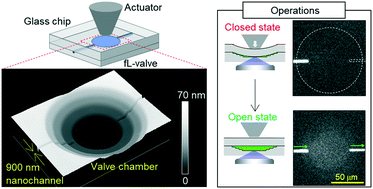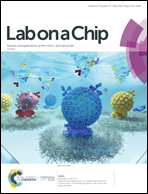Femtoliter nanofluidic valve utilizing glass deformation†
Abstract
In the field of micro/nanofluidics, the channel open/close valves are among the most important technologies for switching and partitioning actions and integration of various operations into fluidic circuits. While several types of valves have been developed in microfluidics, few are capable in nanofluidics. In this study, we proposed a femtoliter (fL) volume nanochannel open/close valve fabricated in glass substrates. The valve consists of a shallow, circular and stepped-bottom valve chamber connected to nanochannels and an actuator. Even with tiny deformation occurring at the nanolevel in glass, an open/closed state of a nanochannel (10–1000 nm) can be achieved. We designed a fL-valve based on an analytical material deformation model, and developed a valve fabrication process. We then verified the open/closed state of the valve using a 308 fL-valve chamber with a four-stepped nanostructure fitting an arc-shape of deflected glass, confirmed its stability and durability over 50 open/close operations, and succeeded in stopping/flowing an aqueous solution at 209 fL s−1 under a 100 kPa pressure in a 900 nm nanochannel with a fast response of ∼0.65 s. A leak flow from the closed valve was sufficiently small even at a 490 kPa pressure-driven flow. Since the developed fL-valve can be applied to various nanofluidic devices made of glass and other rigid materials such as plastic, it is expected that this work will contribute significantly to the development of novel integrated micro/nanofluidics chemical systems for use in various applications, such as single cell/single molecule analysis.



 Please wait while we load your content...
Please wait while we load your content...
